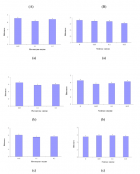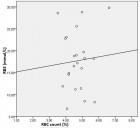Abstract
Research Article
Epidemiologic aspects and risk factors associated with infertility in women undergoing assisted reproductive technology (ART) in north of Iran
Marzieh Zamaniyan, Noushin Gordani*, Paniz Bagheri, Kaveh Jafari, Sepideh Peyvandi, Mojtaba Hajihoseini, Robabeh Taheripanah, Siavash Moradi, Salomeh Peyvandi and Arman Alborzi
Published: 20 January, 2021 | Volume 4 - Issue 1 | Pages: 015-018
Objective: This study aimed to investigating of the epidemiological aspects of infertility and related risk factors in infertile women.
Materials and methods: This cross-sectional study, carried out on 330 infertile women referred to two infertility treatment center of Imam Khomeini Hospital and Mother center in Sari, Iran, from April 2015 to March 2017.
Results: 54.5% of these women were in the age of 30-39 years, infertility duration in 55.2% was 1-5 years, Body mass index (BMI) in 44.5% of samples was 26-30 kg/m2, 54.5% had diploma and associate degree. 63.6% lived in urban areas. 74.5 % of patients reported primary infertility. History of polycystic ovarian syndrome (PCOs) and pelvic inflammatory disease (PID) and poor ovarian reserve were the most common causes and risk factors for the infertility with prevalence 19.42%, 16.81% and 13.91%, respectively. Most underlying disease was thyroid disorders (54.5%). There was found statistically significant relationship between residents of urban areas and infertility duration, endometriosis and educational levels, miscarriage with thyroid. Data analysis performed using IBM SPSS 21 software and Chi-Square test (p < 0.05).
Conclusion: The results showed that women with infertility in north of Iran were more likely to be older, less educated, and also had overweight. They are more possible to have ovarian disorders. In these area, thyroid disease more common like Iodine deficient regions. Future research should be focused on the reasons why majority of women don’t seek treatment for the underline significant diseases that may be effects on ovarian function and fertility.
Read Full Article HTML DOI: 10.29328/journal.cjog.1001079 Cite this Article Read Full Article PDF
Keywords:
Infertility; Women; Risk factor; Epidemiology; Fertilization in vitro
References
- Boivin J, Bunting L, Collins JA, Nygren KG. International estimates of infertility prevalence and treatment-seeking: potential need and demand for infertility medical care. Hum Reprod. 2007; 22: 1506-1512. PubMed: https://pubmed.ncbi.nlm.nih.gov/17376819/
- Zhou Z, Zheng D, Wu H, Li R, Xu S, et al. Epidemiology of infertility in China: a population‐based study. BJOG. 2018; 125: 432-441. PubMed: https://pubmed.ncbi.nlm.nih.gov/29030908/
- Tao X, Ge SQ, Chen L, Cai LS, Hwang MF, et al. Relationships between female infertility and female genital infections and pelvic inflammatory disease: a population-based nested controlled study. Clinics. 2018; 73: e364. PubMed: https://pubmed.ncbi.nlm.nih.gov/30110069/
- Den Heijer CD, Hoebe CJ, Driessen JH, Wolffs P, Van Den Broek IV, et al. Chlamydia trachomatis and the risk of pelvic inflammatory disease, ectopic pregnancy, and female infertility: a retrospective cohort study among primary care patients. Clini Infect Dis. 2019; 69: 1517-1525. PubMed: https://pubmed.ncbi.nlm.nih.gov/31504315/
- Silvestris E, de Pergola G, Rosania R, Loverro G. Obesity as disruptor of the female fertility. Reprod Biol Endocrinol. 2018; 16: 22. PubMed: https://pubmed.ncbi.nlm.nih.gov/29523133/
- Deyhoul N, Mohamaddoost T, Hosseini M. Infertility-related risk factors: a systematic review. Int J Women's Health Reprod Sci. 2017; 5: 24-29.
- Correia S, Rodrigues T, Barros H. Socioeconomic variations in female fertility impairment: a study in a cohort of Portuguese mothers. BMJ open. 2014; 4: e003985. PubMed: https://pubmed.ncbi.nlm.nih.gov/24384900/
- Shreffler KM, Greil AL, McQuillan J. Responding to infertility: Lessons from a growing body of research and suggested guidelines for practice. Family relations. 2017; 66: 644-658. PubMed: https://www.ncbi.nlm.nih.gov/pmc/articles/PMC5798475/
- Kelly-Weeder S, Cox CL. The impact of lifestyle risk factors on female infertility. Women & Health. 2007;44: 1-23. PubMed: https://pubmed.ncbi.nlm.nih.gov/17456461/
- Dembińska AA. Psychological determinants of life satisfaction in women undergoing infertility treatment. Health Psychol Report. 2016; 4: 146-158.
- Mol BW, Tjon-Kon-Fat R, Kamphuis E, van Wely M. Unexplained infertility: Is it over-diagnosed and over-treated? Best Pract Res Clin Obstet Gynaecol. 2018; 53: 20-29. PubMed: https://pubmed.ncbi.nlm.nih.gov/30518485/
- Wischmann TH. Psychogenic infertility—myths and facts. J Assist Reprod Genet. 2003; 20: 485-494. PubMed: https://www.ncbi.nlm.nih.gov/pmc/articles/PMC3455307/
- Karimpour Malekshah A, Esmailnejad Moghaddam A, Moslemizadeh N, Peivandi S, Barzegarnejad A, et al. Infertility in Mazandaran province - north of Iran: an etiological study. Iran J Reprod Med. 2011; 9: 21-24. PubMed: https://www.ncbi.nlm.nih.gov/pmc/articles/PMC4212141/
- Ghi T, Casadio P, Kuleva M, Perrone AM, Savelli L, et al. Accuracy of three-dimensional ultrasound in diagnosis and classification of congenital uterine anomalies. Fertil Steril. 2009; 92: 808-813. PubMed: https://pubmed.ncbi.nlm.nih.gov/18692833/
- Murray CJ, Callender CS, Kulikoff XR, Srinivasan V, Abate D, et al. Population and fertility by age and sex for 195 countries and territories, 1950–2017: a systematic analysis for the Global Burden of Disease Study 2017. Lancet. 2018; 392: 1995-2051. PubMed: https://pubmed.ncbi.nlm.nih.gov/30496106/
- Kamali M, Kashfi F, Baghestani A, Kashani H, Tavajohi S, et al. The epidemiologic survey on causes of infertility in patients referred to Royan Institute. Med J Tabriz Univer Med Sci Health Servi. 2011; 28: 103-105.
- Ikechebelu J, Adinma J, Orie E, Ikegwuonu S. High prevalence of male infertility in southeastern Nigeria. J Obstetr Gynaecol. 2003; 23: 657-659. PubMed: https://pubmed.ncbi.nlm.nih.gov/14617473/
- Moridi A, Roozbeh N, Yaghoobi H, Soltani S, Dashti S, et al. Etiology and Risk Factors Associated with Infertility. Int J Women ̕s Health Reprod Sci. 2019; 7: 346-353.
- Polis CB, Cox CM, Tunçalp Ö, McLain AC, Thoma ME. Estimating infertility prevalence in low-to-middle-income countries: an application of a current duration approach to Demographic and Health Survey data. Hum Reprod. 2017; 32: 1064-1074. PubMed: https://pubmed.ncbi.nlm.nih.gov/28204493/
- Haydardedeoglu B, Zeyneloglu HB. The impact of endometriosis on fertility. Womens Health. 2015; 11: 619-623. PubMed: https://pubmed.ncbi.nlm.nih.gov/26448139/
- Gmyrek GB, Sieradzka U, Goluda M, Gabryś M, Sozański R, et al. Flow cytometric evaluation of intracellular cytokine synthesis in peripheral mononuclear cells of women with endometriosis. Immunol Invest. 2008; 37: 43-61. PubMed: https://pubmed.ncbi.nlm.nih.gov/18214799/
- Tanbo T, Fedorcsak P. Endometriosis‐associated infertility: aspects of pathophysiological mechanisms and treatment options. Acta Obstet Gynecol Scand. 2017; 96: 659-667. PubMed: https://pubmed.ncbi.nlm.nih.gov/27998009/
- Javadi M. Study of the status of smoking, receiving caffeine and mass index of infertile and healthy 25-25 years old women. 2017; 20: 10-7.
- Mohebbi SF, Mohammadzadeh KA. Systematic review of the etiology of the infertility on Iranian domestic published articles between 1999 and 2013. Med Sci J Islam Azad Univer. 2016; 15: 1-5.
Similar Articles
-
TMD and pregnancy?Afa Bayramova*. TMD and pregnancy?. . 2018 doi: 10.29328/journal.cjog.1001001; 1: 001-006
-
Screening of Gestational diabetes mellitusGehan Farid*,Sarah Rabie Ali*,Reem Mohammed Kamal. Screening of Gestational diabetes mellitus . . 2018 doi: 10.29328/journal.cjog.1001003; 1: 014-023
-
Maternal and fetal outcome of comparative study between old & adopted new value of screening of Gestational Diabetes Mellitus in tertiary centre in Saudi ArabiaGehan Farid*,Reem Mohammed Kamal*,Mohamed AH Swaraldahab,Sarah Rabie Ali. Maternal and fetal outcome of comparative study between old & adopted new value of screening of Gestational Diabetes Mellitus in tertiary centre in Saudi Arabia. . 2018 doi: 10.29328/journal.cjog.1001005; 1: 026-034
-
Perinatal Morbidity & Mortality following repeat Cesarean section due to five or more previous Cesarean Section done in Tertiary centre in KSASomia Osman,Gehan Farid*,Reem Mohamed Kamal,Sarah Rabie Ali,Mohamed AH Swaraldahab. Perinatal Morbidity & Mortality following repeat Cesarean section due to five or more previous Cesarean Section done in Tertiary centre in KSA. . 2018 doi: 10.29328/journal.cjog.1001007; 1: 045-051
-
Septic arthritis of left shoulder in pregnancy following minor hand injuryNeelam Agrawal,Rhoughton Clemmey,Shamma Al-Inizi*. Septic arthritis of left shoulder in pregnancy following minor hand injury. . 2018 doi: 10.29328/journal.cjog.1001010; 1: 058-060
-
Value of ambulatory blood pressure measure in pregnancy hypertensionAna Correia*,Fátima Leitão. Value of ambulatory blood pressure measure in pregnancy hypertension. . 2018 doi: 10.29328/journal.cjog.1001012; 1: 067-072
-
Immediate postplacental insertion of intrauterine contraceptive device (copper 375) and its complications in term of expulsion, infection and perforationBenish Khanzada*,Mala Jitendra Shahani,Areesha Kamran Khanzada. Immediate postplacental insertion of intrauterine contraceptive device (copper 375) and its complications in term of expulsion, infection and perforation . . 2018 doi: 10.29328/journal.cjog.1001014; 1: 082-086
-
Managing epileptic women in pregnancySarmad Muhammad Soomar*,Saima Rajpali. Managing epileptic women in pregnancy. . 2019 doi: 10.29328/journal.cjog.1001015; 2: 001-002
-
Autoimmune encephalitis associated with an ovarian teratoma in a 29-year old womanA Plaikner*,A Jacob,J Rother,C Kohler. Autoimmune encephalitis associated with an ovarian teratoma in a 29-year old woman . . 2019 doi: 10.29328/journal.cjog.1001018; 2: 013-016
-
Trans-abdominal cervical cerclage revisitedJohn Svigos*. Trans-abdominal cervical cerclage revisited. . 2019 doi: 10.29328/journal.cjog.1001019; 2: 017-024
Recently Viewed
-
Sinonasal Myxoma Extending into the Orbit in a 4-Year Old: A Case PresentationJulian A Purrinos*, Ramzi Younis. Sinonasal Myxoma Extending into the Orbit in a 4-Year Old: A Case Presentation. Arch Case Rep. 2024: doi: 10.29328/journal.acr.1001099; 8: 075-077
-
Timing of cardiac surgery and other intervention among children with congenital heart disease: A review articleChinawa JM*,Adiele KD,Ujunwa FA,Onukwuli VO,Arodiwe I,Chinawa AT,Obidike EO,Chukwu BF. Timing of cardiac surgery and other intervention among children with congenital heart disease: A review article. J Cardiol Cardiovasc Med. 2019: doi: 10.29328/journal.jccm.1001047; 4: 094-099
-
Advancing Forensic Approaches to Human Trafficking: The Role of Dental IdentificationAiswarya GR*. Advancing Forensic Approaches to Human Trafficking: The Role of Dental Identification. J Forensic Sci Res. 2025: doi: 10.29328/journal.jfsr.1001076; 9: 025-028
-
Scientific Analysis of Eucharistic Miracles: Importance of a Standardization in EvaluationKelly Kearse*,Frank Ligaj. Scientific Analysis of Eucharistic Miracles: Importance of a Standardization in Evaluation. J Forensic Sci Res. 2024: doi: 10.29328/journal.jfsr.1001068; 8: 078-088
-
Toxicity and Phytochemical Analysis of Five Medicinal PlantsJohnson-Ajinwo Okiemute Rosa*, Nyodee, Dummene Godwin. Toxicity and Phytochemical Analysis of Five Medicinal Plants. Arch Pharm Pharma Sci. 2024: doi: 10.29328/journal.apps.1001054; 8: 029-040
Most Viewed
-
Evaluation of Biostimulants Based on Recovered Protein Hydrolysates from Animal By-products as Plant Growth EnhancersH Pérez-Aguilar*, M Lacruz-Asaro, F Arán-Ais. Evaluation of Biostimulants Based on Recovered Protein Hydrolysates from Animal By-products as Plant Growth Enhancers. J Plant Sci Phytopathol. 2023 doi: 10.29328/journal.jpsp.1001104; 7: 042-047
-
Sinonasal Myxoma Extending into the Orbit in a 4-Year Old: A Case PresentationJulian A Purrinos*, Ramzi Younis. Sinonasal Myxoma Extending into the Orbit in a 4-Year Old: A Case Presentation. Arch Case Rep. 2024 doi: 10.29328/journal.acr.1001099; 8: 075-077
-
Feasibility study of magnetic sensing for detecting single-neuron action potentialsDenis Tonini,Kai Wu,Renata Saha,Jian-Ping Wang*. Feasibility study of magnetic sensing for detecting single-neuron action potentials. Ann Biomed Sci Eng. 2022 doi: 10.29328/journal.abse.1001018; 6: 019-029
-
Pediatric Dysgerminoma: Unveiling a Rare Ovarian TumorFaten Limaiem*, Khalil Saffar, Ahmed Halouani. Pediatric Dysgerminoma: Unveiling a Rare Ovarian Tumor. Arch Case Rep. 2024 doi: 10.29328/journal.acr.1001087; 8: 010-013
-
Physical activity can change the physiological and psychological circumstances during COVID-19 pandemic: A narrative reviewKhashayar Maroufi*. Physical activity can change the physiological and psychological circumstances during COVID-19 pandemic: A narrative review. J Sports Med Ther. 2021 doi: 10.29328/journal.jsmt.1001051; 6: 001-007

HSPI: We're glad you're here. Please click "create a new Query" if you are a new visitor to our website and need further information from us.
If you are already a member of our network and need to keep track of any developments regarding a question you have already submitted, click "take me to my Query."

















































































































































